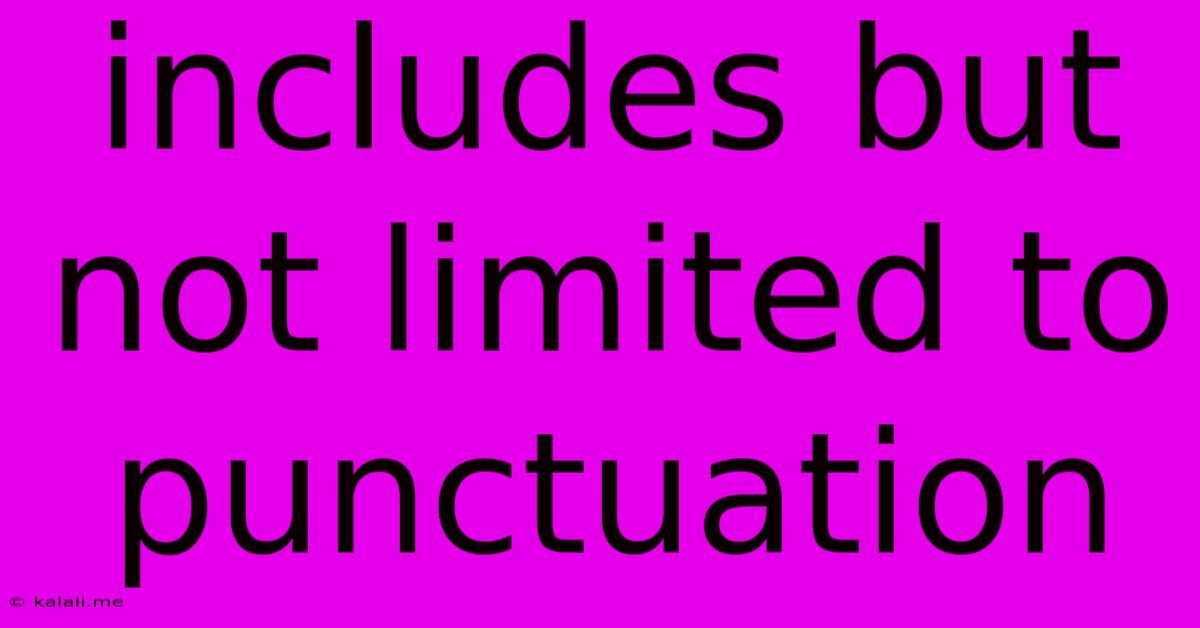Includes But Not Limited To Punctuation
Kalali
May 25, 2025 · 3 min read

Table of Contents
Includes But Not Limited To: A Deep Dive into Punctuation's Power
Meta Description: Discover the often-overlooked power of punctuation! This guide explores the essential punctuation marks, their nuanced uses, and how mastering them elevates your writing. Learn to avoid common mistakes and enhance clarity and impact.
Punctuation. It might seem like a minor detail, a collection of tiny symbols scattered throughout your writing. Yet, these seemingly insignificant marks wield immense power, shaping meaning, clarity, and the overall impact of your message. This article delves into the world of punctuation, exploring its multifaceted role and helping you master its nuances. We'll cover essential marks, common pitfalls, and strategies to elevate your writing to a professional level. This is more than just a grammar lesson; it's a guide to unlocking the true potential of your words.
The Essential Punctuation Marks: Your Writing Toolkit
Mastering punctuation involves understanding the function of each mark. Let's explore some key players:
-
The Period (.): The workhorse of punctuation, signaling the end of a declarative sentence. It's the foundation upon which your sentences are built. Its simple yet crucial function is often underestimated.
-
The Comma (,): A versatile mark used to separate items in a list, clauses in a sentence, and to add clarity and flow. Mastering comma usage is key to avoiding confusing sentence structures. Misusing commas is a common grammatical error, so pay close attention to its rules.
-
The Semicolon (;): This mark connects two closely related independent clauses, adding sophistication and avoiding choppy sentence structures. It's a powerful tool for connecting ideas smoothly.
-
The Colon (:): Used to introduce a list, explanation, or quotation. It creates a pause, signaling that what follows is important or explanatory.
-
The Question Mark (?): Simple yet crucial; it indicates an interrogative sentence, demanding an answer.
-
The Exclamation Mark (!): Used sparingly, it adds emphasis and conveys strong emotion. Overuse can weaken its impact.
-
Quotation Marks (" " or ‘ ’): Used to enclose direct speech, titles of shorter works, and to indicate a word or phrase used in a specific way. Pay attention to single vs. double quotation marks depending on your style guide.
-
Apostrophes (’): Used to show possession and contractions. Mastering their correct use is crucial for grammatical accuracy. Common errors include incorrect placement and omission.
Beyond the Basics: Nuances and Common Mistakes
While understanding the basic functions is essential, true mastery lies in grasping the nuances of punctuation. Here are some common areas where writers stumble:
-
Comma Splices: Joining two independent clauses with only a comma. This is a frequent error; use a semicolon, colon, coordinating conjunction, or separate the clauses into two distinct sentences.
-
Run-on Sentences: Connecting multiple independent clauses without proper punctuation, creating long, confusing sentences. Break them down into shorter, clearer sentences.
-
Incorrect Apostrophe Use: Confusing its usage for plurals or possessive pronouns. Remember, apostrophes show possession (John's book) or contractions (it's).
-
Overuse of Exclamation Marks: While exclamation points can add emphasis, overusing them dilutes their impact and makes your writing appear less professional.
Elevating Your Writing Through Punctuation Mastery
Precise punctuation isn't just about avoiding errors; it's about enhancing the readability and impact of your writing. By mastering these marks, you achieve:
-
Improved Clarity: Precise punctuation ensures your message is easily understood.
-
Enhanced Flow: Proper punctuation creates a natural rhythm and flow, guiding the reader smoothly through your text.
-
Increased Professionalism: Correct punctuation conveys competence and attention to detail.
-
Stronger Impact: Strategic use of punctuation can highlight key information and evoke the desired emotion.
In conclusion, "includes but not limited to" punctuation encompasses a broad range of grammatical elements. While this article covers the essentials, continuous practice and attention to detail are vital for true mastery. By refining your punctuation skills, you unlock the potential to write more clearly, effectively, and powerfully. So, pick up your pen (or keyboard), and let your words shine!
Latest Posts
Latest Posts
-
Single Long White Hair On Body
May 25, 2025
-
How To Factor A Quartic Polynomial
May 25, 2025
-
How To Make Popcorn In Oven
May 25, 2025
-
Based In Or Based Out Of
May 25, 2025
-
How To Remove A Nut From A Stripped Bolt
May 25, 2025
Related Post
Thank you for visiting our website which covers about Includes But Not Limited To Punctuation . We hope the information provided has been useful to you. Feel free to contact us if you have any questions or need further assistance. See you next time and don't miss to bookmark.